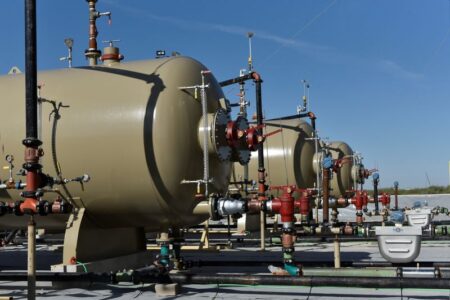Investing.com – If there’s nothing greatly new in your own market to prop it up, you can always borrow a fundamental or two that weakens your rivals — in this case, US Treasuries and the dollar.
Oil prices rose for the first time in three sessions on Tuesday after senior Federal Reserve policy maker Raphael Bostic said the central bank was in no rush to pile rate hikes on Americans to get back under control — though he said a restrictive monetary policy will be necessary to keep spending and jobs growth from getting out of whack with the rest of the economy.
What’s more, Bostic, who’s the Atlanta Fed’s president, threw another bone at risk markets getting clobbered by the surge in that came on the back of the selloff in US bonds and the accompanying spike in the to 11-month highs. He suggested there might even be a rate hike by the end of 2024.
His words were more than a solace for longs in commodities and equities, desperate for a break from the fear factor of a super hawkish Fed that has gripped the investing world again after a respite in the second quarter. Coming ahead of a widely expected rate hike in either November or December — and after September’s pause — it was a sign the central bank might be done with new increases, after its 11 hikes between March 2022 and July 2023.
Bostic also helped offset an utterly bearish mood that gripped markets shortly after the Labor Department reported earlier on Tuesday that the number of job openings in the United States rose more than expected in August, chipping away at some of the confidence the Fed may have had in its fight against inflation.
An estimated 9.61 million jobs opened up in August, according to the Labor Department’s latest monthly Job Openings and Labor Turnover Survey, or JOLTS, report. In July, there were just 8.92 million openings. Wall Street economists’ consensus for August job openings were just around 8.8 million.
The JOLTS report came ahead of the more important September report scheduled for release on Friday. The Fed will be watching that closely to help steer its decision on rates. The central bank has repeatedly said that jobs and wage growth have to cool in order to moderate inflation.
WTI needs to go well above $91 for rebound to gain steam; OPEC meet awaited
New York-traded West Texas Intermediate, or , crude for delivery in November settled at $89.23 per barrel, up 41 cents, or 0.5%. The US crude benchmark hit a three-week low of $87.77 earlier, after losing more than 5% over three prior sessions.
“WTI’s decline paused at around the $86 horizontal support and is beginning to show some recovery to $90,” said Sunil Kumar Dixit, chief technical strategist at SKCharting.com. “Short term, however, a decisive breakout well above $91 will be required to give the rebound steam.”
London-traded for the most-active December contract settled at $90.92, up 21 cents, or 0.2%. The global crude benchmark plunged to a three-week low of $89.56 earlier, after losing more than 6% in three previous days of trading.
Aside from Bostic’s messaging on rates, crude prices were also supported by news of a further delay in efforts to restart Iraqi oil exports via a Turkish pipeline and expectations that producer OPEC+ at its meeting on Wednesday would say something supportive for longs in the game.
“Today was more a borrowed fundamentals day for oil, with the slightly dovish outlook on rates from Bostic tempering some of the might in yields and the dollar that had been clobbering risk markets for days on end,” said John Kilduff, partner at New York energy hedge fund Again Capital.
Market participants were also on the lookout for U.S. weekly oil inventory data, due after market settlement from API, or the American Petroleum Institute.
The API will release at approximately 16:30 ET (21:30 GMT) a snapshot of closing balances on U.S. crude, gasoline and distillates for the week ended Sept. 29. The numbers serve as a precursor to official inventory data on the same due from the U.S. Energy Information Administration on Wednesday.
For last week, analysts tracked by Investing.com expect the EIA to report a build of 0.05 million barrels, versus the 2.170M barrel drop reported during the prior week to Sept. 22.
On the front, the consensus is for a draw of 0.3M barrels over the 1.027M-barrel build in the previous week. Automotive fuel gasoline is the No. 1 U.S. fuel product.
With , the expectation is for a decline of 0.068M, versus the prior week’s gain of 0.398M. Distillates are refined into , diesel for trucks, buses, trains and ships and fuel for jets.
Read the full article here












